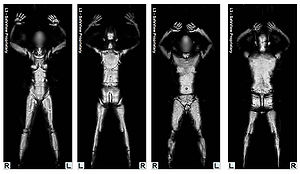This article has multiple issues. Please help improve it or discuss these issues on the talk page. (Learn how and when to remove these messages)
|


A full-body scanner is a device that detects objects on or inside a person's body for security screening purposes, without physically removing clothes or making physical contact. Unlike metal detectors, full-body scanners can detect non-metal objects, which became an increasing concern after various airliner bombing attempts in the 2000s. Some scanners can also detect swallowed items or items hidden in the body cavities of a person. Starting in 2007, full-body scanners started supplementing metal detectors at airports and train stations in many countries.
Three distinct technologies have been used in practice:
- Millimeter wave scanners use non-ionizing electromagnetic radiation similar to that used by wireless data transmitters, in the extremely high frequency (EHF) radio band (which is a lower frequency than visible light). The health risks posed by these machines are still being studied, and the evidence is mixed, though millimeter wave scanners do not generate ionizing radiation.[1]
- X-ray-based scanners
- Backscatter X-ray scanners use low dose radiation for detecting suspicious metallic and non-metallic objects hidden under clothing or in shoes and in the cavities of the human body. The dosage of radiation received is usually between 0.05 and 0.1 μSv[2] Considerable debate regarding the safety of this method sparked investigations, ultimately leading multiple countries to ban the usage of them.
- Transmission X-ray scanners use higher dosage penetrating radiation which passes through the human body and then is captured by a detector or array of detectors. This type of full body scanners allows to detect objects hidden not only under the clothes, but also inside the human body (for example, drugs carried by drug couriers in the stomach) or in natural cavities. The dosage received is usually not higher than 0.25 μSv and is mainly regulated by the American radiation safety standard for personal search systems using gamma or X-ray radiation[3]
- Infra-red thermal conductivity scanners do not use electromagnetic radiation to penetrate the body or clothing, but instead use slight temperature differences on the surface of clothing to detect the presence of foreign objects. Thermal conductivity relies on the ability of contraband hidden under clothing to heat or cool the surface of the clothing faster than the skin surface. Warm air is used to heat up the surface of the clothing. How fast the clothing cools is dependent, in part, on what is beneath it. Items that cool the clothing faster or slower than the surface of the skin will be identified by a thermal image of the clothing. These scanners are less often used compared to X-ray-based and mmWave-based scanners.
Passengers and advocates have objected to images of their naked bodies being displayed to screening agents or recorded by the government. Critics have called the imaging virtual strip searches without probable cause, and have suggested they are illegal and violate basic human rights.[4] However, current technology is less intrusive and because of privacy issues most people are allowed to refuse this scan and opt for a traditional pat-down. Depending on the technology used, the operator may see an alternate-wavelength image of the person's naked body, merely a cartoon-like representation of the person with an indicator showing where any suspicious items were detected, or full X-ray image of the person. For privacy and security reasons, the display is generally not visible to other passengers, and in some cases is located in a separate room where the operator cannot see the face of the person being screened. Transmission X-ray scanners claim to be more privacy neutral as there is almost no way to distinguish a person but they also have a software able to hide privacy issues.
- ^ Harwood, Matthew (March 5, 2010). "Companies Seek Full-Body Scans That Ease Health, Privacy Concerns". Security Management. Archived from the original on October 6, 2014.
{{cite web}}: CS1 maint: bot: original URL status unknown (link) - ^ "'AMAZING RESULTS' OF THE SCANNER THAT 'SEES EVERYTHING'". Moscow Domodedovo Airport. October 2, 2006. Archived from the original on March 3, 2016.
{{cite web}}: CS1 maint: bot: original URL status unknown (link) - ^ Health, Center for Devices and Radiological (June 20, 2019). "Products for Security Screening of People". FDA.
- ^ Pickler, Nedra (March 10, 2011). "Group says body scanners an 'unreasonable search'". The Washington Post.